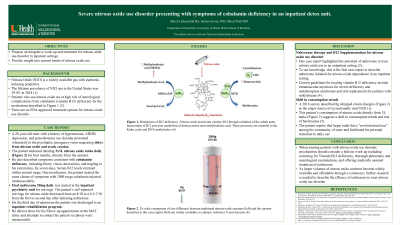Substance Use and Related Disorders
(172) Severe Nitrous Oxide Use Disorder Presenting with Symptoms of Cobalamin Deficiency in an Inpatient Detox Unit.


Maia Hauschild, BA (she/her/hers)
Medical Student
University of Miami Miller School of Medicine
Miami Beach, Florida- SS
Seyma Selen Sevinc, MD
MD
UM/ Jackson Hospitals
Doral, Florida - DP
Dhruti Patel, M.D.
Assistant Professor of Clinical Psychiatry
Miller School of Medicine University of Miami Health System
Miami, Florida
Presenting Author(s)
Co-Author(s)
Background/Significance
Nitrous Oxide (N2O) is a widely available gas with euphoria-inducing properties. The lifetime prevalence of N2O use in the United States was 29.4% in 2014 (Garakani 2011). Patients who use nitrous oxide are at risk of neurological complications from cobalamin (vitamin B12) deficiency (Brunt 2022). There are no FDA-approved treatment options for nitrous oxide use disorder. This case provides insight into current trends of nitrous oxide use and proposes an integrative work-up and treatment for nitrous oxide use disorder.
Case
A 28-year-old unhoused male with a history of ADHD, depression, polysubstance use disorder, and hypertension presented voluntarily to the psychiatric emergency room requesting detox from nitrous oxide and crack cocaine. The patient endorsed inhaling nitrous oxide directly from 3L tanks, and finishing three tanks per day, for four months. He also described symptoms consistent with cobalamin deficiency, including blurry vision, drowsiness, and tingling in his extremities, for seven days. One month prior, the patient successfully treated the same cluster of symptoms with 2000 mcgs cobalamin injected intramuscularly. Oral naltrexone 50mg daily was started in the inpatient psychiatry unit for cravings and serum B12 levels were ordered.
Results
The patient’s self-reported cravings for nitrous oxide decreased from an 8/10 to a 6.5-7/10 from the first to second day after initiating naltrexone. On the third day of admission the patient was discharged to an inpatient rehabilitation program. Serum B12 levels returned within the normal range. He did not show for his follow-up appointment at the MAT clinic and three attempts to contact the patient via phone were unsuccessful.
Discussion
A 2016 survey described 8g whipped cream chargers as the major source of recreationally used N2O (Garakani 2011). Our patient’s consumption of nitrous oxide directly from 3L tanks containing 2000g of nitrous oxide suggests a shift in consumption trends and risk of barotrauma. The patient reports that larger tanks have “revolutionized use” among his community of users and facilitated his personal transition to daily use. One case report highlighted the potential of naltrexone to treat nitrous oxide use in an outpatient setting (Ickowicz 2020). To our knowledge, this is the first case report to describe naltrexone initiated for nitrous oxide dependence in an inpatient setting. It is important to develop integrative treatment algorithms for nitrous oxide use considering the multi-system side effects of chronic use.
Conclusion/Implications
When treating patients with nitrous oxide use disorder, psychiatrists should consider a holistic work-up including screening for Vitamin B12 deficiency, thorough pulmonary and neurological examinations, and offering medically assisted treatment of naltrexone.
References
Garakani A, Jaffe RJ, Savla D, et al:Neurologic, psychiatric, and other medical manifestations of nitrous oxide abuse: A systematic review of the case literature: Toxic Effects of Nitrous Oxide Abuse. Am J Addict 2016; 25(5):358-369.
Brunt TM, Van Den Brink W, Van Amsterdam J:Mechanisms involved in the neurotoxicity and abuse liability of nitrous oxide: a narrative review. IJMS 2022; 23(23):14747.
Ickowicz S, Brar R, Nolan S: Case study: naltrexone for the treatment of nitrous oxide use. Journal of Addiction Medicine 2020; 14(5):e277-e279.
Presentation Eligibility: Not previously published or presented.
Diversity, Equity, and Inclusion: We know that substance use disorders are more prevalent among groups with marginalized identities such as low socioeconomic status and homelessness. Stigmatization of drug use further marginalizes users and prevents people with substance use disorder (SUD) from seeking treatment. People who are marginalized at the intersection of nitrous oxide use and homelessness, such as the patient described in this case, are particularly vulnerable to low vitamin B12 levels due to poor nutritional status. Individuals experiencing homelessness and drug use often end up in inpatient settings to detox. Research is needed to treat these patients in a holistic and evidence-based manner.

